
 




























|
New Antarctic Ozone Data Released 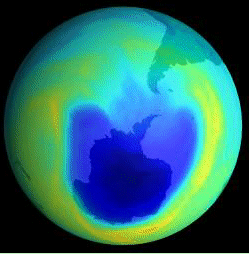
NASA satellites show the size of the region of depleted Antarctic ozone
(shown in blue) extended to a
record 10.5 million square miles on Sept 19,1998. In this image obtained on October 3,
1999 the size of the
Antarctic ozone hole is smaller than it was at the same time last year. Red colors denote
high ozone levels; blue denotes low
October 6, 1999: A NASA satellite has shown that the area of ozone
depletion over the Antarctic -- the well-known ozone "hole" -- is a bit less in
1999 than it was last year.
"This Antarctic year's ozone depletion area, or ozone
'hole,' is very large, but slightly smaller than that of 1998," said Dr. Richard
McPeters, principal
investigator for the instrument that made the measurements.
Peering at the heart of a Crab

September 28, 1999: "Modern astrophysics," an astrophysical
wag once said, "has two areas of study: The Crab Nebula and everything else."
Right: The Crab Nebula as seen by the Chandra X-ray Observatory. The image links to a
533x533-pixel, 54K JPG. Click
here for a 3,000x2,984-pixel, 1.3MB JPG. Credit: NASA and
Chandra Science Center
It's a bit of hyperbole that illustrates a point: The Crab Nebula seems to have most of
what's in the celestial bestiary. It is one of the most spectacular nebulas in the sky.
It's a supernova remnant. It has a pulsar that emits in radio, visible, ultraviolet, and
X-ray wavelengths. It even has
a well-established pedigree since it was sighted by royal Chinese astronomers when light
from the
supernova arrived here in 1054.
"The Crab Nebula and the star at the center of it are the Rosetta Stone of modern
astrophysics,"
said Dr. Martin Weisskopf, Project Scientist for the Chandra X-ray Observatory. The
Rosetta
Stone is a block of black granite (discovered in 1799) inscribed in Greek, Demotic, and
Egyptian
hieroglyphs. From this, archaeologists were able to start decoding the texts of ancient
Egypt.
In like manner, the Crab Nebula has features serve as clues to the inner workings of a
range of astrophysical phenomena. In the last couple of weeks, Chandra and its remarkable
X-ray telescope targeted the Crab
Nebula to collect more clues with the High Resolution Camera. Those images are to be
released today in a Space Science Update at NASA headquarters.
"Right now [before Chandra] we're looking at the glow of activity near the center of
the nebula as you might see the glow of city lights from a distance," Weisskopf said
in a 1998 interview. "Examining the pulsar in
the center using Chandra will be like using a telescope to focus on a single street light
in the middle of the city."
Just How Old Is The Universe, Anyway?
September 27, 1999: Dr. Eyal Maoz of NASA Ames Research Center,
Moffett Field, CA, and
astrophysicists from a variety of U.S. and Canadian institutions have found evidence
suggesting that the universe may be younger than scientists had previously
thought, and that it is expanding faster than expected. Their findings are reported in the
September 23 issue of Nature magazine.
Many current estimates put the age of the universe at about 15 billion years. Maoz'
research indicates the universe may be as young as 12 billion years, nearly
the same age as its oldest stars. This implied relatively low age of the universe could
revive an old paradox in the field of astro- physics that the universe seems to be younger
than some of the stars in it.
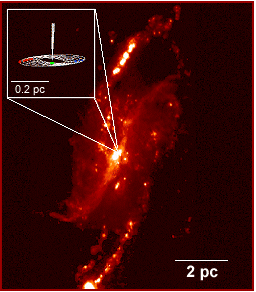
Above: This optical image shows the core region of galaxy NGC 4258. By measuring the
motions of microwave lasers in a disk orbiting a central supermassive black hole,
astronomers can estimate the distance to this galaxy very accurately. By comparing maser
distance measurements with Cepheid
distance estimates of NGC 4258, Maoz et al realized that the widely used Cepheid distance
scale overestimates galaxy distances. That means the Universe may be younger than
previously thought.
Maoz and his team used the Hubble Space Telescope to observe the pulsing of giant stars
called "Cepheid variables" in the galaxy NGC4258.
Researchers used a standard "Cepheid measurement" technique that allowed them to
measure the distance from Earth to the galaxy. However, this measurement was different
from another independent, highly
accurate distance determination to that galaxy made using masers (the microwave
equivalent of lasers), which are located at the galaxy center and orbiting a super-
massive black hole. This means that the Cepheid distance scale may need tweaking.
A revision of the standard Cepheid measurement method would mean that estimates for the
age of the Universe would have to be revised downwards by 10-15%, experts say.
Measuring galactic distances using Cepheid variables has been a standard since 1929. They
are
useful because their rate of pulsation is closely linked to their brightness. This means
that a
galaxy's apparent brightness can be used to gauge its distance from Earth.
Maoz and his colleagues used the Cepheid method to estimate the distance from Earth to the
benchmark NGC4258 galaxy as 8.1 megaparsecs (Mpc), significantly farther than the
geometric estimates derived by recent estimates. (One Mpc is equivalent to approximately
three million light years.)
"We discovered a considerable discrepancy between the maser-based and Cepheid-based
distance," Maoz said. "The bottom line is that it seems that galaxy distances
may have been
consistently overestimated by about 12%. This would imply that the universe is expanding
faster than expected, and the age of the universe is lower by a similar factor."
See Hubble Constant for more about the Hubble Constant,
cosmology, and the size and age of the Universe.
Maser and Lasers
Know the difference between a Maser and a Laser? You will after reading this
article.
Gravity B Probe
Einstein and the Gyroscope revisted?
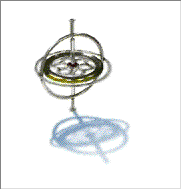
World's Most Accurate Clocks?
The best clocks are getting even better. Cesium, Mercury, Hydrogen and beyond...
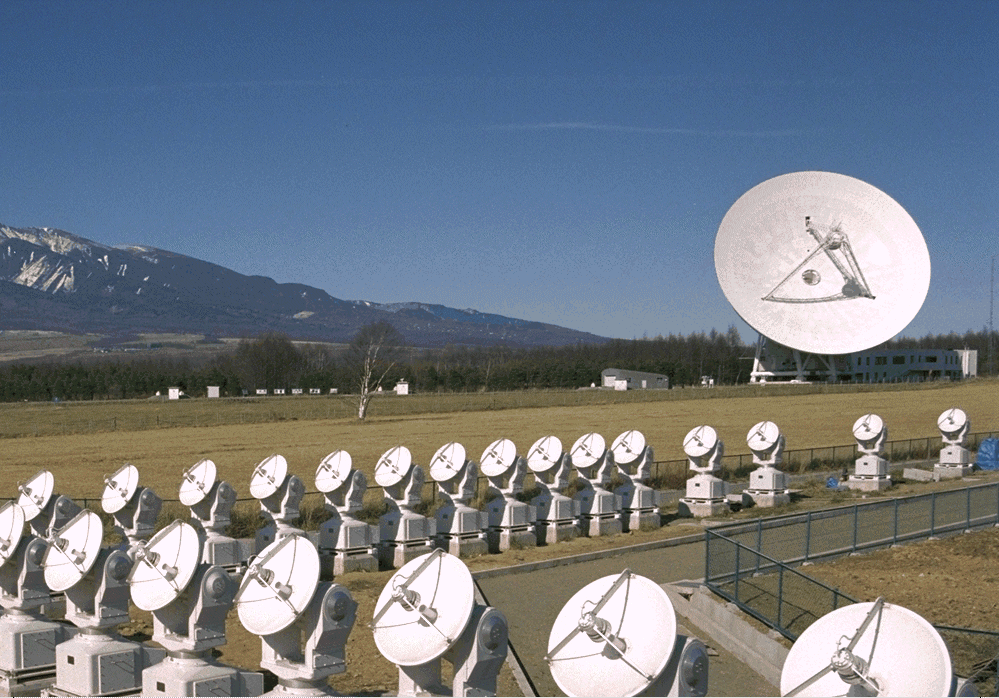
Radio Astronomy Page
Radio Astronomy is an important tool for exploring the universe and is constantly adding
to our knowledge. Check it out!
Optical Astronomy
Optical Astronomy has been with us for thousands of years and earth bound instruments
still continue to produce impratntr results.
Total Solar Eclipse
"To witness a total eclipse of the Sun is a privilege that
comes to but few people. Once seen, however, it is a phenomenon never to be forgotten. The
black body of the Moon standing out ... in sinister relief between Sun and Earth, the
sudden outflashing glory and radiance of the pearly corona which can be seen at no other
time, the scarlet prominences rising from the surface of the hidden Sun to heights of many
thousand miles, the unaccustomed presence of the brighter stars and planets in the
daytime, the darkness of twilight and the unusual chill in the air. There is something in
it all that affects even the strongest nerves and it is almost with a sigh of relief that
we hail the return of the friendly Sun."
Isabel M. Lewis, 1924
A Handbook of Solar Eclipses
On Wednesday, August 11, a total eclipse of the Sun was visible from within a narrow
corridor that traverses densely populated areas of the Earth. The path of the Moon's
umbral shadow began in the Atlantic and crossed Central Europe, the Middle East, and India
where it ended at sunset in the Bay of Bengal. A partial eclipse was visible within the
much broader path of the Moon's penumbral shadow that included northeastern North America,
all of Europe, northern Africa and the western half of Asia.
You can watch the eclispse in real time on the WWW at
http://eclipse99.ksc.nasa.gov/.

|
Eugene M.
Shoemaker (1928-1997)
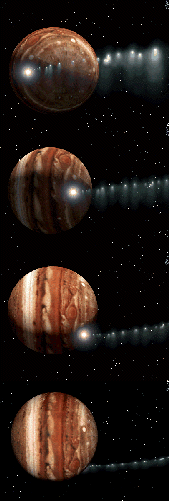
From July 16 through July 22, 1994, pieces of an object designated as Comet
P/Shoemaker-Levy 9 collided with Jupiter. This is the first collision of two solar system
bodies ever to be observed, and the effects of the comet impacts on Jupiter's atmosphere
have been simply spectacular and beyond expectations. Comet Shoemaker- Levy 9 consisted of
at least 21 discernable fragments with diameters estimated at up to 2 kilometers.
Robert Goddard
(1893-1956)
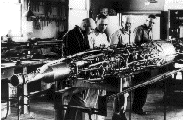
"It is difficult to say what is impossible, for the dream of yesterday is the
hope of today and the reality of tomorrow."
-Dr. Robert H. Goddard
The Hubble Constant

Edwin Hubble (l889-1953 )
Edwin P. Hubble, was staff astronomer at Carnegie Institution's Mount Wilson
Observatory in California from 1919-1953.
In the 1920s, there was a serious debate over whether galaxies were part of the Milky Way.
Using the theoretical groundwork of Henrietta Swan-Leavitt and Harlow Shapley, Hubble's
revolutionary observational work proved that galaxies are indeed "island
universes". Hubble also outlined a classification system for galaxies that is still
in use. Hubble proved that the fuzzy "nebulae" were not part of our galaxy, but
were themselves galaxies, external to the Milky Way.
His greatest discovery was the linear relationship between a galaxy's distance and the
speed with which it is moving. The ratio of the two is known as the Hubble
Constant. A key project of the Hubble Space Telescope is to find the value of the
Hubble Constant to greater accuracy, in order to resolve several questions of cosmology.
Hubble co-discovered the velocity-distance relation, which led to the concept of the
expanding universe. The general picture of the universe established in his work remains at
the heart of present-day cosmology.
Hubble was born in 1889 in Marshfield, Missouri. His undergraduate studies at the
University of Chicago emphasized mathematics and astronomy, and led to the B.S. degree in
1910. He spent the next three years as a Rhodes scholar at Oxford, where he studied in the
field of law and received the M.A. degree. He returned to astronomy at the Yerkes
Observatory of the University of Chicago, where he earned the Ph.D. in 1917.
|